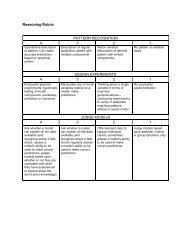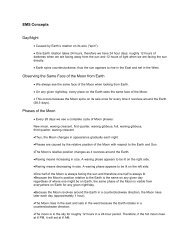Science Education Reform - National Center for Improving Student ...
Science Education Reform - National Center for Improving Student ...
Science Education Reform - National Center for Improving Student ...
Create successful ePaper yourself
Turn your PDF publications into a flip-book with our unique Google optimized e-Paper software.
TACKLING THE QUESTION<br />
The disjointed nature of science<br />
instruction during the K–8 and secondary<br />
years is a problem that needs<br />
to be seriously addressed, according<br />
to Schauble and Lehrer. (See also<br />
Raizen, p. 5) “So far, we know from<br />
observing the re<strong>for</strong>m movement that<br />
there is a great need <strong>for</strong> careful<br />
thought and choices about what is<br />
most worth accomplishing in school<br />
science,” states Schauble. “Although<br />
the standards movements have been<br />
important in helping to develop a<br />
sense of good science learning and<br />
teaching, there are still far too many<br />
visions at play, ranging from science<br />
concepts, processes, the history of<br />
science, and the nature of science, to<br />
science, society, and technology. How<br />
are we going to build a solid research<br />
base about student learning in science<br />
without good agreement about<br />
what school science is? In our view,<br />
focus is badly needed. And that focus<br />
should come not from what we have<br />
historically done, but from careful<br />
consideration of both core disciplinary<br />
themes and how children’s understanding<br />
of those themes develops.”<br />
We are not going to make any<br />
progress in re<strong>for</strong>m until we<br />
make some choices about the<br />
focus of science education<br />
within a wider perspective of<br />
our goals <strong>for</strong> students’ learning.<br />
— Rich Lehrer &<br />
Leona Schauble<br />
At the secondary level, Lehrer<br />
points out, some thoughtful discussions<br />
are occurring about the value<br />
of building science curricula around<br />
students’ increasing understanding of<br />
important scientific ideas. For example,<br />
there are proposals to invert<br />
the usual sequence of high school<br />
courses so that physics, the foundational<br />
science, is taught first, followed by chemistry and finally by biology.<br />
“The dilemma is,” Lehrer continues, “What do we do with science education<br />
in the K–8 years? All the issues about what to teach during these years<br />
are still on the table, even if there is some profitable discussion occurring<br />
about what to teach at the secondary level.” To address this gap, Lehrer and<br />
Schauble propose that professionals from various disciplines work together<br />
to tackle the pressing task of building a science education strategy that connects<br />
topically across grades. “We suggest, based on our experience, that we<br />
can use an educational approach that integrates modeling in instruction. Still,<br />
we need to decide what models are most worth focusing on. We are presently<br />
using a series of criteria <strong>for</strong> making these decisions. We select fundamental<br />
themes or ‘big ideas’ in science that play a central role in scientific disciplines<br />
(an example is the theme of ‘diversity’ in biology). We favor themes<br />
that can be entered easily by young children, but that provide plenty of ‘lift’<br />
and challenge <strong>for</strong> older students. Moreover, we emphasize core concepts that<br />
are amenable to the modeling approach that we are committed to.”<br />
“Once core concepts are identified,” Lehrer adds, “researchers and teachers<br />
will be in position to build a knowledge base about students’ thinking. We<br />
believe that instructional decisions should be guided by knowledge about<br />
how students’ ideas develop, including typical patterns and frequent variants.<br />
A teacher with this knowledge is in a good position to capitalize on the<br />
ideas that emerge in classroom inquiry, turning them toward scientifically<br />
fruitful directions. Robust understanding of the typical pathways of children’s<br />
thinking can also help prepare preservice teachers to teach science effectively.”<br />
SPANNING DISCIPLINES TO BUILD THE MOVEMENT<br />
Like Angelo Collins (see p. 2), Lehrer and Schauble perceive value in education<br />
researchers, scientists, teachers, and psychologists communicating with<br />
one another about the best ways to teach children science and what science<br />
to teach kids. This cross-disciplinary communication, Schauble notes, seems<br />
to be increasing. “Until the last 10 years,” Schauble observes, “science and<br />
mathematics were disciplines that seldom talked to each other. We were in a<br />
similar situation with science educators and psychologists who study scientific<br />
reasoning. Now, under the leadership of a few individuals, that is beginning<br />
to change. Now people are crossing across the ‘boxes’ — the traditional<br />
disciplinary divisions that have kept us apart. We are realizing that we are<br />
working on similar problems and that it is very important that we learn from<br />
each other. As this happens, our specializations evolve.”<br />
Schauble and Lehrer feel that their research has been enriched as they<br />
have crossed traditional disciplinary divisions, and they urge that a crossdisciplinary<br />
approach can likewise strengthen science education re<strong>for</strong>m ef<strong>for</strong>ts.<br />
“The contribution we are making is that we have disciplinary knowledge<br />
of development and learning, and we are working at the boundaries of what<br />
have hereto<strong>for</strong>e been separate domains: psychology, teaching, learning, mathematics,<br />
and science. We think it is important to consider the intersections<br />
between these separate domains. Because researchers and professionals are<br />
sequestered in their various fields, we are not used to having a common language<br />
or a common point of view. It is critical that we try to develop a common<br />
vision across people and positions — both in the research realm and the<br />
practice realm — and across several levels of analysis (from the student, to<br />
the classroom, school, district, community, state, and nation) to deal concretely<br />
with science education re<strong>for</strong>m. We need to have a much more nuanced<br />
view of teaching and learning.”<br />
(continued . . . )<br />
9





